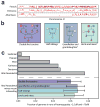The complete genome sequence of a Neanderthal from the Altai Mountains
- PMID: 24352235
- PMCID: PMC4031459
- DOI: 10.1038/nature12886
The complete genome sequence of a Neanderthal from the Altai Mountains
Abstract
We present a high-quality genome sequence of a Neanderthal woman from Siberia. We show that her parents were related at the level of half-siblings and that mating among close relatives was common among her recent ancestors. We also sequenced the genome of a Neanderthal from the Caucasus to low coverage. An analysis of the relationships and population history of available archaic genomes and 25 present-day human genomes shows that several gene flow events occurred among Neanderthals, Denisovans and early modern humans, possibly including gene flow into Denisovans from an unknown archaic group. Thus, interbreeding, albeit of low magnitude, occurred among many hominin groups in the Late Pleistocene. In addition, the high-quality Neanderthal genome allows us to establish a definitive list of substitutions that became fixed in modern humans after their separation from the ancestors of Neanderthals and Denisovans.
Conflict of interest statement
The authors declare no competing financial interests.
Figures










Comment in
-
Archaic humans: Four makes a party.Nature. 2014 Jan 2;505(7481):32-4. doi: 10.1038/nature12847. Epub 2013 Dec 18. Nature. 2014. PMID: 24352230 No abstract available.
References
-
- Mednikova MB. A proximal pedal phalanx of a paleolithic hominin from Denisova cave, Altai. Archaeology Ethnology & Anthropology of Eurasia. 2011;39:129–138. http://dx.doi.org/10.1016/j.aeae.2011.06.017. - DOI

